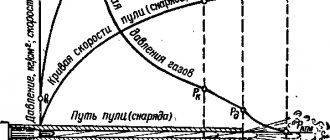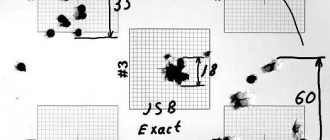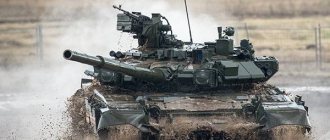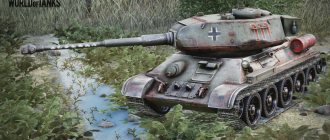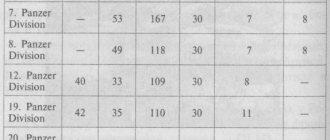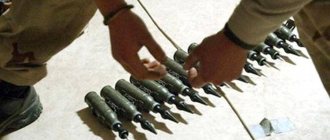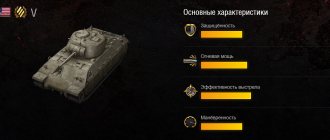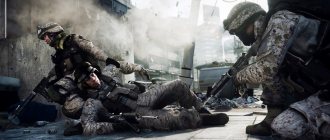Causes, nomenclature and effects on the human body
The United States, following the principle of creating advanced weapons to support its political ambitions, constantly tested new models in various military conflicts. Considerable attention was paid to ammunition in the designs of which depleted uranium was used. The results of testing of ammunition containing depleted uranium carried out in the Persian Gulf did not satisfy the Americans, and they continued them in the war against Yugoslavia. The American side tried to hide the consequences of the tests on the effects on the human body by allegedly not yet investigating physical laws. In fact, research into the nature of the impact of the use of depleted uranium on the ecological environment, including the human body, has been carried out in the United States since the late 1960s, and to date, appropriate assessment methods have been developed.
Reasons for using depleted uranium
Since the late 1960s, the US Department of Defense has paid increased attention to ammunition that penetrates armor due to the high kinetic energy of the projectile. This was explained by the increased ability of multilayer armor to withstand the effects of cumulative ammunition, as well as the desire to increase the penetrating power of armor-piercing sub-caliber projectiles (APS).
The most important development in the creation of highly effective armor-piercing projectiles was the use of depleted uranium, a by-product of the nuclear industry, as a structural material.
Tungsten was previously the most commonly used structural material. However, the further use of tungsten in the production of ammunition was limited by the following reasons.
Tungsten is one of the rare metals: its content in the earth's crust is approximately 0.0006%. The main suppliers of tungsten on the world market are Bolivia, South Korea and Canada. Three quarters of the world's tungsten reserves are concentrated in China. The US Department of Defense has repeatedly expressed concern that focusing ammunition production solely on tungsten could create a critical situation if the source is lost. The growing consumption of tungsten (indispensable in a number of industries) leads to a rapid increase in its cost. Considering these circumstances, as well as the fact that the technological process for producing cores from tungsten, its compounds and alloys is quite complex, the interest that was once shown by the US Department of Defense in searching for an equivalent replacement is understandable. After conducting experimental studies with a number of heavy metals and their alloys, it was found that the most successful replacement for tungsten is depleted uranium. As follows from the comparative data (Table 1), depleted uranium is very close in density to tungsten. It should be added that the cost of finished uranium-based cores is three times less than the cost of tungsten cores.
Due to the high density at the existing initial velocities of anti-tank gun projectiles, uranium BPSs acquire significant kinetic energy when fired, providing armor-piercing ability comparable to the penetration qualities of tungsten-based BPSs.
Depleted uranium reserves in the United States amount to hundreds of thousands of tons, while the annual consumption of tungsten in recent years was about 10,000 thousand tons, of which the Department of Defense received no more than 10%.
Prerequisites for the use of depleted uranium in BPS
One of the important properties of uranium as a material for BPS is pyrophoricity, that is, the ability to spontaneously ignite and burn as a result of impact with armor and friction when passing through armor. The pyrophoric nature of such projectiles provides a significantly greater armor protection effect than tungsten-based projectiles.
To improve the physical and mechanical properties, depleted uranium is used in armor-piercing projectiles in the form of alloys with small additions of alloying elements: titanium, molybdenum, etc. The compositions of some alloys published in the materials of the Research Center for Materials Science and Mechanics of the US Army are contained in (Table 2 )
A number of research organizations, laboratories, universities and companies were engaged in research on the creation of BPS based on depleted uranium in the United States. To date, the number of organizations involved in the use of uranium in ammunition has increased significantly due to its use in warheads of guided weapons.
The damaging effect of a rod warhead: a) – the formation of a rod ring; Vс – the speed of the rods due to the detonation of the explosive; Vр – rocket speed; V – speed of the rod ring; b) – “cutting off” the wing of an airplane. Drawing by the author
The main supplier of depleted uranium cores for BPS was the American company Nuclear Metals Inc. After manufacturing, the cores were supplied to Chamberlain Manufacturing Company and Flinchbauqh Manufacturing Company, which were responsible for assembling 105-120 mm BPS.
The European NATO countries, led by Germany, are pursuing their own technical policy for creating BPS, which is different from the policy of the United States, which continues to rely on the use of uranium. In Germany, the 120-mm BPS DM53 (armor penetration 320 mm/60 degrees, at a range of 2 km) has been adopted, which does not have a depleted uranium core, but has high armor penetration.
Uranium armor-piercing shells
To date, BPS using uranium form the basis of the ammunition stock of US tank and anti-tank guns. These include the 120-mm BPS M829A2, which uses a guide device made of composite material instead of aluminum, which significantly reduces the weight of the shot. A sharp increase in elongation using depleted uranium allowed this projectile to achieve armor penetration of 370 mm/60 deg. at a distance of 2 km. The frontal protection fragments of domestic tanks cannot combat this ammunition, since they have significantly lower armor resistance.
In the Soviet Union, work was also underway to create a BPS using depleted uranium. The 125-mm BPS 3BM32 adopted for service achieved armor penetration of 250 mm/60 degrees, which is not enough to destroy the Leopard-2A6 and M1A2 Abrams tanks when shelling their frontal zones (Fig. 1).
At the same time, depleted uranium was used to create new shells for automatic small-caliber guns of the US Air Force, Navy and Ground Forces, which made it possible to increase the effectiveness of combat against armored targets. The use of depleted uranium in ammunition for small-caliber guns has made it possible to reach a qualitatively new level in increasing the effectiveness of the fight against tanks. The new armor-piercing 30 mm incendiary projectile for the GAU-8/A cannon, which uses depleted uranium, was a key factor in the effectiveness of the attack aircraft, designed specifically for combating tanks in the European theater of operations.
Design diagram of an armor-piercing incendiary 30-mm projectile for the GAU-8/A cannon (mass characteristics): shot weight 0.75 kg; shot length 290 mm; projectile weight 0.43 kg; projectile length 140 mm; sleeve weight 0.146 kg; sleeve length 173 mm; gunpowder weight 0.156 kg; initial speed 988 m/s. Drawing by the author
The 30-mm projectile for the GAU-8/A cannon was developed by the US Air Force Weapons Laboratory, mass production of which began in 1978 (Fig. 2). Work on its creation lasted about 10 years. The most labor-intensive were the selection of the alloy for the core, the development of the projectile design, and production technology that guarantees an acceptable cost.
The production cost of the projectile was $15, of which the depleted uranium core accounted for about $5. The US Department of Defense ordered tens of millions of these projectiles. The high efficiency of the 30 mm projectile was the impetus for the development of a suspended container that houses a 4-barreled 30 mm gun with a rate of fire of 2400 rounds per minute and an ammunition capacity of 350 rounds. With the help of the container, the goal was to expand the anti-tank capabilities of a number of aircraft through the use of effective cannon weapons. At the same time, 20-mm BPS were manufactured using depleted uranium in relation to the 6-barreled Felanks installation, intended for the close zone of protecting ships from cruise missiles.
Depleted uranium has recently been widely used by the US Department of Defense to produce highly effective armor-piercing projectiles to increase strategic reserves, especially in the European theater of operations.
Official statistics show that the following uranium-containing ammunition was mainly used in Iraq, Kuwait and Yugoslavia: 30 mm armor-piercing shells for GAU-8/A aircraft guns of A-10A attack aircraft; M829A1 BPS for the guns of the M1A1 Abrams tanks. In total, 9 thousand pieces of the above-mentioned ammunition were used in these military conflicts, the total mass of depleted uranium of which was 300 tons.
In solving the problems of using depleted uranium in the production of ammunition, the following research work was carried out: development and study of the properties of alloys based on depleted uranium; study of the processes of melting, casting, rolling, forging and pressing of a uranium alloy with 0.75% titanium; production of depleted uranium cores for 105 and 120 mm tank guns, 30 and 20 mm automatic gun shells; assembly of shells with depleted uranium cores intended for 105 and 120 mm tank guns; development of a 120 mm sub-caliber projectile with a depleted uranium core for the main tank gun; study of the characteristics of uranium particles formed during the interaction of armor-piercing cores with armor; comparative assessment of the ballistic characteristics of armor-piercing cores made of depleted uranium and tungsten; development of compositions and technologies for applying anti-corrosion coatings to a depleted uranium core; study of the corrosion resistance of various uranium alloys; melting and casting of homogeneous uranium alloys.
- Reasons for using depleted uranium
- Prerequisites for the use of depleted uranium in BPS
- Uranium armor-piercing shells
- The effect of depleted uranium on the human body
- What is the US range of ammunition using depleted uranium?
Material "B"
Continuation. For the beginning, see “TV” No. 2. 2001.
Candidate of Technical Sciences Mikhail Rastopshin
USE OF LEAN CARRIAGE IN NONNUCULAR AMMUNITION
The United States, following the principle of actively creating advanced weapons to support its political ambitions, constantly tests new models in various military conflicts. Considerable attention was paid to tests in real combat conditions of ammunition in the designs of which depleted uranium is used.
The scale of such tests carried out in the Persian Gulf did not satisfy the Americans, and they continued them in the war against Yugoslavia. The American side is trying to hide the consequences of these tests on the effects on the human body by allegedly still unexplored physical laws accompanying the combat use of these ammunition. In fact, research into the nature of the impact of the use of depleted uranium on the ecological environment, including the human body, has been carried out in the United States since the late 60s, and appropriate assessment methods have now been developed.
Reasons for using depleted uranium
Since the late 60s, the US Department of Defense has paid increased attention to ammunition that penetrates armor due to the high kinetic energy of the projectile. This was explained by the increased ability of multilayer armor to withstand the effects of cumulative ammunition, as well as the desire to increase the penetrating power of armor-piercing sabot projectiles (APS) and significantly expand the arsenal of highly effective anti-tank weapons through the use of aircraft guns.
The most important milestone in the development of armor-piercing projectiles was the use of depleted uranium, a by-product of the nuclear industry, as a structural material.
Tungsten has been the most widely used structural material for the production of BPS cores. However, the further use of tungsten in the production of ammunition was limited by the following reasons. Tungsten is one of the rare metals: its content in the earth's crust is approximately 0.0006%. The main suppliers of tungsten on the world market are Bolivia, South Korea and Canada. Three quarters of the world's tungsten reserves are concentrated in China. Since imports of tungsten concentrate into the United States account for about 50%, the US Department of Defense (DoD) has repeatedly expressed concern that focusing only on tungsten in ammunition production could create a critical situation in the event of loss of sources. The growing consumption of tungsten (an irreplaceable material in a number of industries) leads to a rapid increase in its cost. Considering these circumstances, as well as the fact that the technological process of producing cores for BPS from tungsten, its compounds and alloys is quite complex, the interest that the US Department of Defense showed at one time in searching for an equivalent replacement is understandable. After conducting experimental studies with a number of heavy metals and their alloys, it was found that the most successful replacement for tungsten alloys is depleted uranium. As follows from the comparative data (Table 1), depleted uranium is very close in density to tungsten. It should be added that the cost of finished uranium-based cores is three times less than the cost of tungsten cores.
Due to the high density, at the existing initial velocities of anti-tank gun projectiles, uranium BPS acquire significant kinetic energy when fired, providing armor-piercing ability comparable to the penetration qualities of tungsten-based BPS.
Depleted uranium reserves in the United States amount to hundreds of thousands of tons, while the annual consumption of tungsten in recent years was about 10,000 thousand tons, of which the Department of Defense accounted for no more than 10%.
Table 1.
| Uranus | ||
| Atomic weight | 183,85 | 238,02 |
| Density, g/cm? | 19,35 | 19,05 |
| Melting point, C | 3410 | 1130 |
Prerequisites for the use of depleted uranium in BPS
One of the important properties of uranium as a material for BPS is pyrophoricity, i.e. the ability to spontaneously ignite and burn as a result of impact with armor and friction when passing through armor. The pyrophoric nature of such projectiles provides a significantly greater armor protection effect than tungsten-based projectiles.
To improve the physical and mechanical properties, depleted uranium is used in armor-piercing projectiles in the form of alloys with small additions of alloying elements: titanium, molybdenum, etc. The compositions of some alloys, published in the materials of the Research Center for Materials Science and Mechanics of the US Army, are given in Table 2.
Research on the creation of BPS based on depleted uranium in the USA was carried out by a number of research organizations, university laboratories and companies. To date, the number of organizations involved in the use of uranium in ammunition has increased significantly due to the use of material “B” in warheads of guided weapons.
The main supplier of cores for depleted uranium BPS is the American company Nuclear Metals Inc., they are supplied to Chamberlain Manufacturing Company and Flinchbaugh Vanufacturing Company, which are responsible for assembling 105 and 120 mm BPS.
It is impossible not to notice that the European NATO countries, led by Germany, are pursuing their own technical policy for creating BPS, which is different from the policy of the United States, which continues to rely on the use of depleted uranium. Germany has adopted the 120-mm BPS DM 53, which does not have a depleted uranium core, but has high armor penetration. Switzerland and the Netherlands were the first customers of this projectile, ordering 20 thousand and 16 thousand pieces, respectively.
Uranium armor-piercing shells
To date, BPS using uranium form the basis of the ammunition stock of US tank and anti-tank guns. These include the 105mm BPS M833 and the 120mm BPS M829A2, which is the latest upgrade of the M829A1 projectile. The M829A2 projectile uses a tray made of composite material instead of aluminum, which significantly reduces the weight of the shot. A sharp increase in elongation using material “B” allowed this projectile to exceed the 300 mm/60° barrier in armor penetration. The frontal protection fragments of domestic tanks cannot combat this ammunition, since they have significantly lower armor resistance (“TiV” No. 7, 1998).
In the Soviet Union, work was also underway to create a BPS using uranium. The 125-mm BPS EBM32, which was put into service, achieved armor penetration of 250 mm/60°, which is not enough to destroy the Leopard-2A6 and M1A2 Abrams tanks when shelling their frontal zones.
At the same time, depleted uranium was used to create new shells for automatic small-caliber guns of the US Air Force, Navy and Ground Forces, which made it possible to increase the effectiveness of combat against armored targets. Thus, at one time, the US Air Force Weapons Laboratory developed a 30-mm armor-piercing incendiary projectile for the GAU-8/A cannon, mass production of which began in 1978. The cost of the projectile in production was $15, of which the depleted uranium core accounted for about 5 dollars. The US Department of Defense ordered tens of millions of these shells. The high efficiency of this 30 mm projectile was the impetus for the development of the Gepod 30 hanging container, which houses a 4-barrel 30 mm cannon with a rate of fire of 2400 rounds per minute and a capacity of 350 rounds of ammunition. With the help of this container, the goal was to expand the anti-tank capabilities of a number of aircraft through the use of effective cannon weapons. At the same time, 20-mm BPS were manufactured using uranium in relation to the 6-barreled Phalanx installation, intended for close-in protection of ships from cruise missiles.
Over the past two decades, depleted uranium has been widely used by the US Department of Defense to produce highly effective armor-piercing projectiles to increase strategic stockpiles, especially in the European theater.
Official statistics indicate that the following uranium-containing munitions were primarily used in Iraq, Kuwait and Yugoslavia:
30 mm armor-piercing shells for GAU-8/A aircraft guns of A-10A attack aircraft;
M829A1 BPS for the guns of the M1A1 Abrams tanks.
In total, about 900 thousand units were used in these military conflicts. the above-mentioned ammunition, the total mass of depleted uranium is 300 tons.
It should be noted that work on the use of depleted uranium in ammunition was also carried out in Great Britain, Germany and France.
Table 2.
| The basis | Content of alloying elements, % | ||||
| Uranus | Titanium | Molybdenum | Zirconium | Vanadium | Niobium |
| 0,75 | — | — | — | — | |
| — | 2,0 | — | — | — | |
| 0,5 | 0,75 | 0,75 | 0,3 | 0,75 | |
| 0,5 | 0,85 | — | — | 0,85 |
The effect of depleted uranium on the human body
Back in 1977, the US Armaments Laboratory carried out firing of 105-mm projectiles containing a depleted uranium core with 0.75% titanium at the Aberdeen Proving Ground. The purpose of these experimental studies was to establish the nature of the destruction of the core and generalize the results for subsequent analysis of the impact of the use of depleted uranium ammunition on the environment.
Wednesday. During these tests, it was established that when the core interacts with the armor, it is destroyed with the formation of a large number of particles suspended in the air. Particle sizes vary widely: from macroparticles with a diameter of more than 50 microns to aerosols at the submicron level. Most of the particles have a spherical or ellipsoidal shape, indicating exposure to high temperature, melting and subsequent crystallization. The fragments formed upon impact with the armor spontaneously ignited; their combustion in air was exothermic and self-sustaining.
The formation of a large number of suspended particles during the interaction of the uranium core with the armor even then set the Americans the task of assessing their effect on the human body when such particles entered the lungs. It was found that the most important factor is not the radioactive impact, which is small, but the nature of the chemical impact of uranium, its oxides and other products formed upon collision with the armor.
Among NATO troops stationed in the zone where uranium ammunition was used particularly intensively, serious illnesses, even fatal ones, were observed. At the same time, blood cancer was detected in 400 peacekeeping soldiers in Yugoslavia.
And finally, the position of US representatives regarding the illnesses of NATO personnel and civilians in Yugoslavia is interesting. The essence of this position is the lack of scientifically based initial data to answer this question. Note that the Los Alamos scientific laboratory was involved in research into the effect of long-term exposure to depleted uranium on the environment, as well as the distribution of uranium particles and fragments upon impact of the BPS with armor. It is hard to believe that the scientists of this laboratory are not able to evaluate this event.
125-mm round ZBBM13 with BPS ZBM32:
1 Housing 4.23 kg 2 Drive ring 2.07 kg 3 Drive belt 0.025 kg 4 Stabilizer 0.435 kg 5 T-20-1 tracer 0.03 kg 6 Additional powder charge 2.5 kg 0.4 kg 7 Propelling powder charge 4 .6 kg 0.7 kg 8 Sleeve 0.425 kg 9 Pallet 3.4 kg 10 Impact bushing GUV-7 0.087 kg
30 mm projectile for the CAU-8/A cannon:
shot weight 0.75 kg projectile weight 0.43 kg case weight 0.146 kg gunpowder weight 0.156 kg shot length 290 mm projectile length 140 mm case length 173 mm initial speed 988 m/s
What is the US range of ammunition using depleted uranium?
During the eruption of the scandal caused by the consequences of the use of uranium ammunition in Yugoslavia, their nomenclature is persistently hushed up. In other words, information about the types of ammunition used that contain uranium in their design was not made public. The existing references that such ammunition includes BPS for anti-tank and small-caliber aircraft guns is very limited information, which hides a whole arsenal of various types of ammunition with depleted uranium.
At the same time, the scale of the cynical action, the number and heterogeneity in vulnerability of the targets allows us to predict the possible range of American ammunition with depleted uranium.
One of the important areas for increasing the efficiency of cumulative warheads (warheads) of anti-tank guided missiles (ATGMs) and anti-ship cruise missiles (ASCMs) is the use of uranium lining in their design, from which a cumulative jet is formed. At one time, American firms were developing a new class of improved warheads of anti-tank missiles, which used cumulative linings made of depleted uranium (Military Technology, - 1985, -Vol.9, No. 12. - P. 44–54). A uranium cumulative jet has greater armor-piercing ability and armor-protection effect than a copper jet. What is the armor effect of a uranium cumulative jet? Such a cumulative jet, for example, when applied to hitting a tank with an anti-tank missile, will cause a very intense fire inside it and an increase in temperature to 250 °C. The action of the uranium cumulative jet of anti-ship missile warheads will make it possible to effectively destroy surface combat ships, as well as tankers, which will be accompanied by powerful fires.
Ammunition specialists know that the use of high-density metals as lining of warheads based on the impact core principle significantly increases the effectiveness of self-aiming combat elements. The use of uranium lining in warheads of self-aiming elements “Skeet” and “Sadarm” dramatically increases the effectiveness of such weapons due to the enhanced pyrophoric effect on the units inside armored vehicles.
Of no small importance is the use of depleted uranium in the warheads of missile defense systems and air-to-air missiles. Thus, under conditions of size and mass restrictions, the use of uranium rods in the rod warhead of air-to-air missiles sharply increases their penetrating ability, which ensures the “cutting” of the wings and fuselage of aircraft. In other words, depleted uranium becomes a component of guided weapon warheads.
Thus, the basis of the US ammunition nomenclature using depleted uranium is probably:
anti-aircraft guided missiles with rod warheads;
air-to-air missiles with rod warheads;
anti-ship cruise missiles with cumulative warheads;
anti-tank guided missiles;
cluster self-aiming and homing combat elements; shots for anti-tank grenade launchers;
armor-piercing shells for anti-tank and small-caliber aircraft guns.
One of the main tactical and technical requirements when creating weapons is the presence of its own raw material base. Following this requirement, the Americans solved an important strategic problem for themselves by replacing tungsten with depleted uranium, which the United States has in abundance, when creating ammunition.
Thanks to the use of depleted uranium, it was possible to significantly (at least 30%) increase the effectiveness of the destructive action of the considered weapons.
Table of contents
The effect of depleted uranium on the human body
Back in 1977, the US Armament Laboratory conducted 105 mm projectiles containing a depleted uranium core with 0.75% titanium at the Aberdeen Proving Ground. The purpose of the experimental studies was to establish the nature of the destruction of the core and generalize the results for subsequent analysis of the impact of the use of depleted uranium ammunition on the environment.
During testing, it was established that when the core interacts with the armor, it is destroyed with the formation of a large number of particles suspended in the air. Particle sizes vary widely: from macroparticles with a diameter of more than 50 microns to aerosols at the submicron level. Most of the particles have a spherical or ellipsoidal shape, indicating exposure to high temperature. The fragments formed upon impact with the armor self-ignited, their combustion in the air was exothermic and self-sustaining.
The formation of a large number of suspended particles during the interaction of the uranium core with the armor set the Americans the task of assessing their effect on the human body when such particles enter the lungs. It was found that the most important factor is not radioactive exposure, but the chemical effect of uranium, its oxides and other products formed upon impact with the armor.
Severe illnesses were observed among NATO troops stationed in the zone where uranium ammunition was used particularly intensively. Even with a fatal outcome. At the same time, blood cancer was detected in 400 American soldiers in Yugoslavia.
And finally, the position of US representatives regarding the illnesses of NATO personnel and civilians in Yugoslavia is interesting. The essence of the position is to hide the scientifically based initial data to answer this question. Note that the scientific laboratory in Los Alamos was studying the influence of long-term exposure to depleted uranium on the environment, as well as the distribution of particles and fragments of uranium during the collision of the BPS with armor. It is hard to believe that the scientists of this laboratory are not able to evaluate this event.
Andrey Ulanov “Silver bullets with a uranium core”
Books of this kind have always amazed me. I love SF very much, almost more than fantasy - not least because there are no elves and other dwarves in them. But it would still be possible to endure that even there, in the future, nothing other than them could be found. Let be. But everything else...
No, the author, of course, is great for earning himself such a name under which they are willing to publish even such complete nonsense - I just feel very sorry for those talented authors, whom I personally know, who have MUCH more fascinating works, MUCH better written, with MUCH more non-standard twists and ideas and MUCH more complex and interesting characters, who, for reasons that no one understands, are rejected by the editors. But there are places occupied by authors like Ulanov, who write exclusively in clichés and in an extremely boring manner.
Essentially the book itself. Disgusting language: the author begins a sentence, gets distracted by something else, and after N sentences suddenly remembers that he left something unsaid, and ends a long-lost thought. A lot of “memories on the topic”, well, like “back then I saw, and now...” - why didn’t I write when I saw it? This all smacks of unscriptedness, as if the author was shot at something along the way, and he immediately stuck it in, a la pianos in the bushes. Well, phrases like “I still didn’t understand what she was trying to prove...” simply kill. Why not have a dialogue? Even though the GG did not understand, the reader would have seen for himself the conversation, the meaning that escaped the hero, and the formation of relationships between the speakers. However, it is clear why it is not shown: because the author does not know how to write dialogues, they are all standard, formulaic and boring. And when the heroes, one of them at that, suddenly start joking with jokes from the 20th century, five hundred years ago in terms of the time of action, then it doesn’t look “cool” at all, but pathetic and stupid. Well, it’s as if we suddenly started joking with jokes from the 17th century. The hero remembers his grandmother, then his grandfather, then some senior officers, cadets, and even misinterprets Matroskin. Well, okay, one or two would be fine, but the bunch of non-functioning phantoms with which the reader is cluttered is starting to get incredibly boring.
Not a single fragment of the book caught my attention or took me away. If at first there was still hope, then in the end I openly scrolled through. The writing is blurry, no pictures appear, as if the author himself has no idea what he is writing about, or does not know how to properly describe it.
The hero is given a task to be accepted into a special organization. The task itself is stupid, but oh well. It is clear that he will fulfill it. Well, I would have done it as soon as possible - and the adventures began. But no, this all drags on for a whole book, they move somewhere indistinctly over and over again, the connecting fragments are crumpled and cut off, in general - green melancholy. The equipment is standard, the environment is too. There are no ligaments.
The characters are a special case.
Main. Well, the fact that the character is stereotyped and inexpressive is okay. But a person goes to alien worlds. Goes to sell weapons. Read, young generation, and learn! Selling weapons is good, but if you manage to rob someone personally using this very weapon, it’s even better. Just think, a couple of hundred innocent people, defenders of the treasures, will die! What is human life? Ugh! Kill, dear ones, rob, because this is exactly what current literature teaches you. Look at GG - he didn’t even have a thought that he was wrong, not to mention a little bit of conscience. I killed everyone and was glad. I wonder if the author is also perplexed as to why crime and lawlessness are growing, or is he just preaching?
Women... Well, what can we take from a man? Cinderella is a collection of twitchy strokes, not connected into a single personality. So she sells ships while taking drugs, breaks a bunch of laws and provokes shooting, getting arrested; immediately tries to hang bows on the imp (is this the one that almost destroyed half the city?!); then suddenly she goes to sell stones that cannot be sold in order to buy garbage (why wasn’t she told that selling them was dangerous?! Why wasn’t this discussed?!), and immediately during the fight she begins to worry about the dress... (those who worry about dresses , and not about their own condition, they do not know how to focus on the enemy and so on - they are simply not able to learn how to fight, especially at such a level as to twist a young lady carrying weights that a man was not able to carry). In addition, from somewhere, her super-genius abilities as a chemical designer periodically awaken, each time as a piano in the bushes. The man is messing around, the woman is trying to construct something with the help of a chip. A poet's dream.
The second beautiful, but endlessly stupid Amazon is even worse, it’s boring to talk about her. Her death is fast and emotionless, does not cause anything and passes by the reader. GG, who himself brought her into this, for some reason suddenly wants to take revenge on someone there. The absurdity makes me want to shrug my shoulders.
By the way, about the fight. Boys love to fight, measure their strength, arrange friendly fights, and it is quite likely that two men, having fought, would hug and become friends, “respecting” each other. For women, as a rule, everything is different. They don’t fight over trifles (the maximum is a useful slap in the face :)), and once they fight... do they suddenly become friends after that? Considering that the author hints that both were looking at Ch. hero?! Yes, they would rather become a ball of snakes, stinging not only each other, but also everyone around them, than make friends. At least in this situation.
Bes-Cheburashka with eyes a la the cat from “Shrek”, a completely useless character, periodically performing the functions of an unconvincingly broken “chip”, which, according to the idea and the properties inherent in it, should outlive its owner in any situation. I kept expecting him to turn out to be at least a spy sent. But no. Complete boredom...
A saber that cuts everyone, is alive, with its own name and character - a technique that is so often sucked into literature that it is not even worthy of attention. However, the saber has almost no effect and is easily forgotten by the author at the end of the book. That's where she goes.
The organization is poorly defined, its goals are not clear to anyone at all. However, in a world where it is considered normal to go shoot unarmed people, it is quite possible that it is impossible to come up with anything more complex in terms of a control system. It serves them right, that a total secret body rules over everyone with impunity. Which, however, is not able to find out who he is recruiting, at least by DNA analysis (just think, another person was registered above - but what about the body?!) In general, this transformation of the GG evokes an emotion like “Tut-tut-tut”
Swam. At first, from the dialogue, I understood that he was a gnome, since there were only two speakers and the elf was saying that the gnome had heated wood in the morning. Then I decided that they were talking about another gnome, but I still didn’t understand Swam’s race. Separately, it must be said that wherever the GG goes, he immediately meets extremely useful individuals, well-disposed, calmly mowing down the mafia ranks of any worlds and eager to go with him, GG, no matter where, because for some reason they consider his path to be the Path of all Paths . Luckily (and not described at all how) you come across super cool partners. Not a single scoundrel, not a single deceiver - well, what can we take from the postulate “the more power, the worse the magician.” It is clear that the strongest and most evil are the stupidest, and why they were not defeated earlier is not at all clear.
It’s not at all clear what the ships and space are for, except maybe defeating a dragon with a sofa is the height of science fiction. The title of the book is also sewn behind the ears. Like these bullets themselves, it is unknown why and how they were created, but, naturally, they were used at the most crucial moment. A bunch of left-wing discussions, like the death of some baron (on three pages), who doesn’t appear anywhere at all. A witch who can make people transparent with all their outfits, but for some reason not a bag of money. Cinderella managed to seize the toilet from the stolen ship. That is, she ended up with a toilet after the ship was stolen. Unlike a chip, the chip turns on exactly when needed. Ait failed to explain who Dyke is, and again without dialogue solely for the sake of the author.
Dyke, by the way, stands out somewhat from the general field, because it is a stamp from another area. However, I’m not at all interested in reading how the GG will look for her, and I won’t, even if there is a continuation.
Bottom line: I’m unlikely to take on Ulanov again; the complete lack of interesting ideas, captivating narrative, and three-dimensional characters makes me think of big connections in the publishing house.

